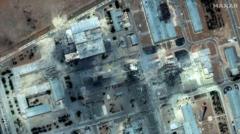Following US military actions in June, an Israeli official suggests that Iran might still access enriched uranium buried at Isfahan, but any attempts are likely to trigger further Israeli airstrikes. This assertion diverges from US intelligence assessments, which indicate some damage but not total destruction of Iran's nuclear facilities.
Israeli Official Warns Iran May Retrieve Enriched Uranium From Struck Facilities

Israeli Official Warns Iran May Retrieve Enriched Uranium From Struck Facilities
A senior Israeli intelligence official claims Iran could recover enriched uranium from the Isfahan site despite US military strikes.
Israeli officials have voiced concerns that Iran could potentially retrieve enriched uranium from its nuclear facility in Isfahan, which was one of three sites targeted by US forces during airstrikes on June 22. Speaking to US reporters, a senior Israeli military official indicated that while locating the enriched uranium would be challenging, any Iranian efforts to do so would likely provoke a swift response from Israel.
The mention of enriched uranium comes amid continued rhetoric from former President Donald Trump, who asserts that the US military actions "obliterated" Iran's nuclear capabilities. However, conflicting views from various US intelligence agencies suggest a more nuanced reality; while the strikes caused significant damage, they did not completely dismantle the sites in question.
The Israeli official, who remained unnamed, pointed out that it is intelligence suggesting much of Iran's enriched uranium remains buried at the Isfahan site, currently under scrutiny, which was attacked as part of an operation named "Midnight Hammer." Despite the potential for recovery, the Israeli assessment claims that Iran's nuclear advancement has been delayed by approximately two years.
White House spokesperson Anna Kelly echoed Trump's sentiments, stating that due to these actions, global safety has improved. However, a leaked Defense Intelligence Agency report contradicts claims of total destruction, emphasizing that while damage to the facilities at Fordo, Natanz, and Isfahan was severe, some structures remain intact.
On the other hand, International Atomic Energy Agency (IAEA) Director Rafael Grossi cautioned that not all facilities have been destroyed, highlighting the necessity of a careful and comprehensive evaluation of the damage. Iranian President Mahmoud Pezeshkian lamented that although the facilities are significantly damaged, a complete assessment and access remain unattainable.
As tensions persist and the geopolitical landscape grows increasingly complex, analysts warn against the unpredictable threats posed by Iran’s nuclear ambitions.





















